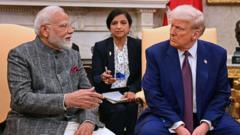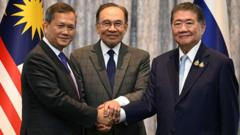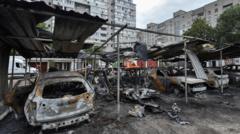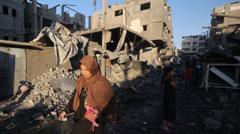Following intense air strikes by India deep within Pakistani territories, both nations emerge claiming victories. The conflict, triggered by a terrorist attack in Kashmir, threatens to spiral further as casualties mount and diplomatic channels remain under pressure.**
Tensions Escalate: India and Pakistan Claim Victories After Air Strikes**

Tensions Escalate: India and Pakistan Claim Victories After Air Strikes**
In a dramatic escalation of hostilities, both India and Pakistan assert their military successes following airstrikes across their disputed border. Analysis of the aftermath raises questions about potential pathways to de-escalation.**
---
In a significant escalation of military tensions, both India and Pakistan have emerged from a series of air strikes claiming victories as a complex narrative unfolds following recent hostilities. The conflict ignited after a devastating terrorist attack in Kashmir, which India attributed to elements within Pakistan, leading to a robust response characterized by strategic air strikes across the border.
During the early hours of May 7, Indian jets executed strikes hitting multiple sites purportedly used by militant groups within Pakistan. Reports indicate extensive damage and casualties, with Pakistan asserting that it mounted a defense that successfully downed one or more of India's attacking aircraft, igniting a war of narratives over the true outcomes of the conflict.
By Wednesday evening, both nations appeared to be evaluating their respective situations. India carried out its most aggressive operations to date against targets on Pakistani soil, which they claim were necessary to deter future terrorist threats, citing at least twenty casualties from air strikes concentrated around known militant strongholds. However, returning reports from Pakistani sources and independent observers detail that several Indian jets were compromised, underlining the high stakes involved in this latest round of aerial conflict, reminiscent of tensions faced during previous skirmishes, including those in 2019.
The dynamics following these strikes create a precarious scenario, as both nations grapple with the implications of potential escalation or avenues towards de-escalation. International observers now watch closely to see if either side is inclined to pursue diplomatic engagement to mitigate further military escalation or if they will continue on a path fraught with risk. In this environment, claims of military prowess coincide with rising fatalities, complicating both domestic narratives and international perspectives toward a fragile Kashmir.
In a significant escalation of military tensions, both India and Pakistan have emerged from a series of air strikes claiming victories as a complex narrative unfolds following recent hostilities. The conflict ignited after a devastating terrorist attack in Kashmir, which India attributed to elements within Pakistan, leading to a robust response characterized by strategic air strikes across the border.
During the early hours of May 7, Indian jets executed strikes hitting multiple sites purportedly used by militant groups within Pakistan. Reports indicate extensive damage and casualties, with Pakistan asserting that it mounted a defense that successfully downed one or more of India's attacking aircraft, igniting a war of narratives over the true outcomes of the conflict.
By Wednesday evening, both nations appeared to be evaluating their respective situations. India carried out its most aggressive operations to date against targets on Pakistani soil, which they claim were necessary to deter future terrorist threats, citing at least twenty casualties from air strikes concentrated around known militant strongholds. However, returning reports from Pakistani sources and independent observers detail that several Indian jets were compromised, underlining the high stakes involved in this latest round of aerial conflict, reminiscent of tensions faced during previous skirmishes, including those in 2019.
The dynamics following these strikes create a precarious scenario, as both nations grapple with the implications of potential escalation or avenues towards de-escalation. International observers now watch closely to see if either side is inclined to pursue diplomatic engagement to mitigate further military escalation or if they will continue on a path fraught with risk. In this environment, claims of military prowess coincide with rising fatalities, complicating both domestic narratives and international perspectives toward a fragile Kashmir.




















